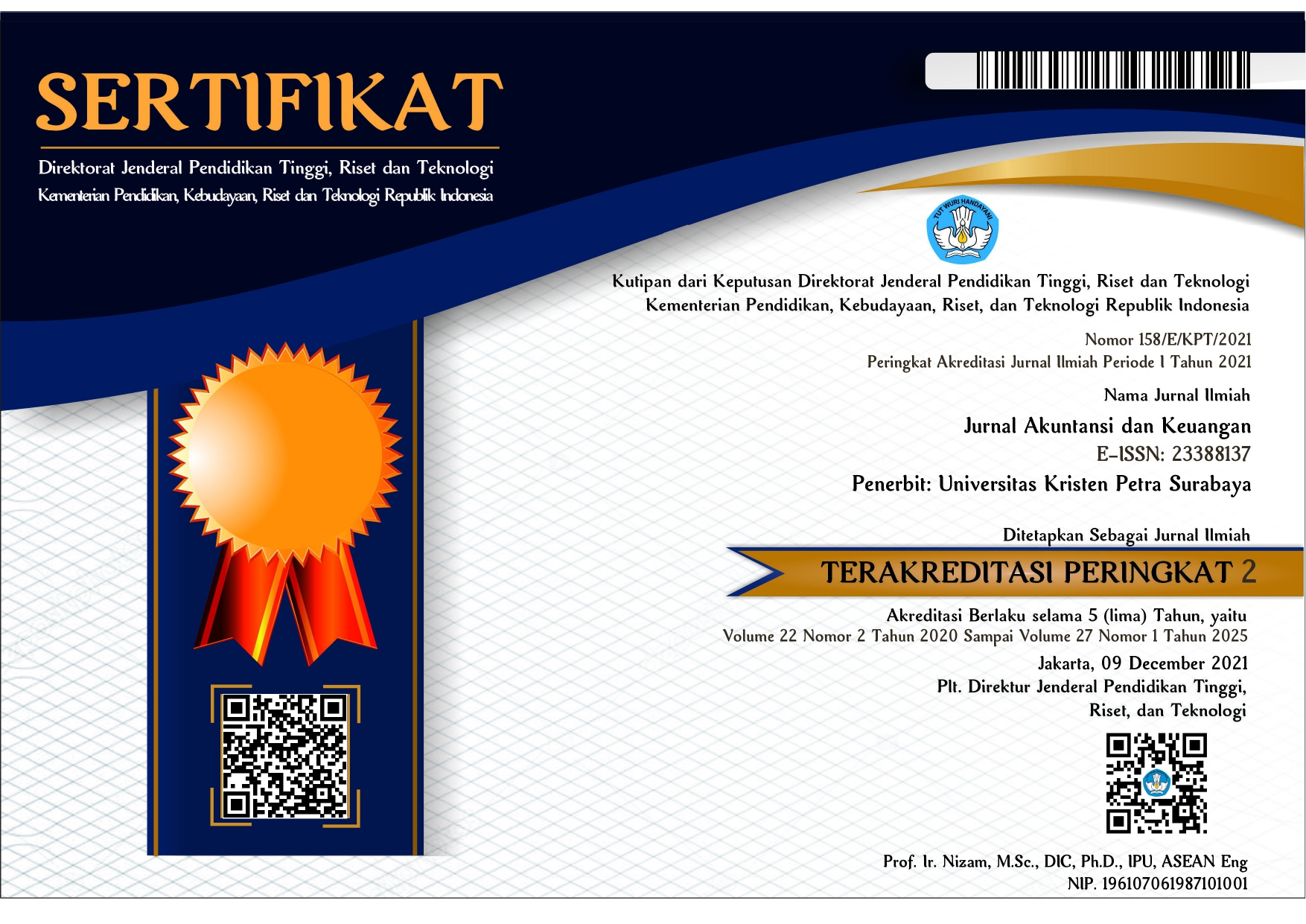An Indirect Impact of the Price to Book Value to the Stock Returns: An Empirical Evidence from the Property Companies in Indonesia
DOI:
https://doi.org/10.9744/jak.17.2.91-96Keywords:
Dividend payout ratio, return on equity, growth, degree of financial leverage, price to book value, stock returns.Abstract
This research empirically examines the influence of Dividend Payout Ratio (DPR), Return on Equity (ROE), Growth, and Degree of Financial Leverage (DFL) on the Price to Book Value (PBV) of the property companies in Indonesia. It also attempts to explore the indirect effects of the DPR, ROE, Growth, and DFL on the stock returns via the PBV. 36 property firms, which are listed in the Indonesian Stock Exchange from 2007 to 2013, were selected to be analyzed using the Path Analysis. The result of this research indicates that the variable of growth is found to have a significant impact on PBV. Meanwhile, the DPR, ROE, and DFL were found to be insignificant. The DPR, ROE, Growth, and DFL were found to affect PBV simultaneously. This study also proved that the PBV has a significant effect on the stock returns, while the DPR and DFL were not. The study also found that the DPR, PBV, and DFL have simultaneously affected stock returns of the property companies in Indonesia. The finding of this study implied that to predict the stock returns of the property companies, the investors and companies should take into account the changes in the growth and PBV.References
Fama, E. and French, K. (1992). Cross Section of Expected Stock Returns, Journal of Finance, 47(2), 427-450.
Hartono, M. J. (2000). Teori Portofolio dan Analisis Investasi, 2nd Edition, Yogyakarta: BPFE.
Husnan, S. (2005). Dasar-dasar Teori Portofolio dan Analisis Sekuritas, 4th Edition, Yogyakarta: UPP AMP YKPN.
Jones, C. P. (2000). Investments: Analysis and Management. 7th Edition, New York: John Wileys & Sons.
Rosenberg, B., Kenneth R., and Lanstein, R. (1985). Persuasive Evidence of Market Inefficiency, Journal of Portfolio Management, 11(9), 1-17.
Sarwono, J. (2007). Analisis Jalur untuk Riset Bisnis dengan SPSS, 1stEdition, Yogyakarta: ANDI.
Sharma, S. (2011). Determinants of Equity Share Price in India, Journal of Arts, Science & Commerce, 2(4), pp. 51-60.
Tandelilin, E. (2001). Analisis Investasi dan Manajemen Portofolio, 1st Edition, Yogyakarta: BPFE.
Utama, S. and Anton Y. B. S. (1998). Kaitan antara Rasio Price/Book Value dan Imbal Hasil Saham pada Bursa Efek Jakarta, Jurnal Riset Akuntansi Indonesia, 1(1), 27-140.
Vaidyanathan, R. and Sudheer C. (1997). Stock Returns and Price to Book Value Ratio, The Icfai Journal of Applied Finance, 3(2), 45-53.
Wardjono. (2010). Analisis Faktor-faktor yang Mempengaruhi Price to Book Value dan Implikasinya pada Return Saham pada Perusahaan Manufaktur yang terdaftar di BEI, Dinamika Keuangan dan Perbankan, 2(1), 83-96.
Wilcox, J. W. (1984). The P/B-ROE Valuation Model, Financial Analysis Journal, 2, 58-66.
Wirawati, Ni G. T. (2008). Pengaruh Faktor Fundamental Perusahaan terhadap Price to book Value dalam Penilaian Saham di Bursa Efek Jakarta dalam Kondisi Krisis Moneter, Buletin Studi Ekonomi, 13(1), 92-102.
Downloads
Published
How to Cite
Issue
Section
License
Authors who publish with this journal agree to the following terms:
- Authors retain the copyright and publishing right, and grant the journal right of first publication with the work simultaneously licensed under a Creative Commons Attribution License that allows others to share the work with an acknowledgement of the work's authorship and initial publication in this journal.
- Authors are able to enter into separate, additional contractual arrangements for the non-exclusive distribution of the journal's published version of the work (e.g., post it to an institutional repository or publish it in a book), with an acknowledgement of its initial publication in this journal.
- Authors are permitted and encouraged to post their work online (e.g., in institutional repositories or on their website) followingthe publication of the article, as it can lead to productive exchanges, as well as earlier and greater citation of published work (See The Effect of Open Access).<a href="http://creativecommons.org/lice














